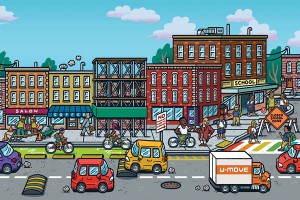Market Report: World at Your Feet
Vinyl isn’t a bad word anymore. In fact, you can scratch it right off your never-utter-aloud-in-public list. This surface, once relegated to outdated kitchens and bathrooms of decades long gone, has fast become the darling of new and remodeled homes everywhere. Add to the mix the relatively new flooring phenomena of laminates and the classic look of hardwoods, and the flooring choices for homeowners stretch beyond strictly functional to downright funky, fun and fashionable.
The Wonder Twins of Flooring
Where once carpeting was a shoe-in for living rooms and bedrooms, the trend today is anything goes, with any floor suitable—and doable—for every room. “Category and price used to go hand in hand,” says Roger Oates, vice president of marketing for Armstrong in Lancaster. “But vinyl and laminates have let us do anything. It’s not so much of a price point anymore.”
Although it’s easy to maintain and has a warmer and softer feel than some other surfaces, vinyl’s biggest selling point seems to be its huge design capability. “Vinyl allows you to have lots of design creativity,” says Oates. “It has also become popular in urban areas because it is so hip.”
Armstrong’s new Urban Settings collection is the perfect example of this new flooring funkiness with designs like the Crocodile, a reptile-skin-looking surface in Albino, Nile Black and Everglade; the Vienna, a patchwork of predominately square, rectangle and geometric shapes; and Twinkle, a dreamy, whimsical design dotted with subtle stars.
But while vinyl is earning a reputation as a versatile design diva, its sister surface, laminate, is quickly becoming known as an all-around über-floor. “Armstrong introduced laminates in 1996 and it has been growing double-digits ever since,” says Oates. Because of its hard surface, it is incredibly wear resistant, making it practical and popular for high-traffic areas. But, like vinyl, it also is a warmer surface than something like ceramic tile.
“I chose laminates over the others for several reasons,” says Jim McGillen of Marlton, New Jersey, who recently decided to gut his mother’s entire kitchen and redo everything. “Speed and ease of installation, appearance, durability and selection.”
All of McGillen’s reasoning pinpoints just why laminates have become a trend in flooring. “Most of its popularity stems from the fact that it is essentially a hybrid of every other surface and can mimic wood, ceramic and tile floors,” says Oates. Taking ease and authenticity a step further, Armstrong has just introduced a multiwidth laminate that mimics hardwood and actually comes in two different sized planks and snaps together—just like a traditional hardwood floor.
Tile size also has become a big option in the flooring world. According to Oates, the old adage for choosing a tile size used to be “the smaller the room, the smaller the tile size should be.” But that’s no longer the case. Standard tile size was once 6 inches, but that has blossomed to 10, 12 and 16, even 24-by-24-inch tiles. “Houses are getting bigger and rooms are getting bigger,” says Oates. “Living spaces have changed with more open spaces and with kitchens running into living rooms.” Larger-sized tiles are a natural choice to help rooms flow into one another.
Awash in Color
What’s hot and trendy in the world of fashion has a direct impact on what’s happening under your feet. “When it comes to design, cultural trends obviously have a big influence,” says Mary-Angela Kenney, general manager of product styling and design for Armstrong. Just one of the big cultural trends is feng shui, which Armstrong has translated into flooring by using natural tones such as wood, metal, slate, sisal, paper and stone, and finishes of pearl and metal, or a combination of materials.
“People are placing a lot more emphasis on the home and using home as a place to find balance,” says Kenney. Because of this, the home also becomes the sanctuary and a place to escape. This explains the emerging trend of tropical and exotic designs. “We’re seeing a lot more white-on-white, darker woods, palms and florals, and tropical weaves,” she says.
A few more emerging trends include denim, bohemian-chic or rich hippie with a homespun-knit look, and an Americana treatment of stars and stripes, deep reds, strong blues and soft neutrals.
“There’s a movement toward cleaner lines,” says Oates. “There used to be lots of floral patterns when it came to floors, then the ‘80s ushered in an all-white look which wasn’t practical. Today we’re seeing demand for the warmth of natural colors.”
A Class Act
While it’s true that a bevy of new flooring options has grabbed center stage in today’s housing market, an old favorite also has seen some increased spotlight—hardwood floors.
“We have had such a large resurgence in sales over the last few years,” says Mark Prengle, sales manager for Charles Taylor & Sons in Yorklyn, Delaware. “I think people are realizing the investment pays off: they last a lifetime and as far as resale value, people never walk into a house and say ‘I hate the wood floors.’”
Another reason behind its popularity is actually health related. Prengle believes more people are opting for hardwood because of molds and allergens found in carpeting. “It’s a healthier alternative,” he says.
For Alisa Argentina of Marlton, New Jersey, there was absolutely no question that hardwood floors would be blanketing her living room, dining room and family room floors. “My husband (an ex-contractor) is a purist, so we had to go with hardwood and I’m so happy we did,” she says. “There isn’t a person, stranger or not, that doesn’t come into the home or look at pictures and say to us ‘Wow, your floors are beautiful.’”
Argentina, who also chose hardwood for its longevity and interior design factor selected different hues for different rooms. “For the living and dining room I wanted a lighter to medium color,” she says. “This helps it to look a little more formal and brings the light in beautifully.” In the family room Argentina wanted a more rustic, lodge-like look, so she chose a golden oak color.
“Floors are so important,” Argentina says. “They can make or break an entire home’s decoration.”
In terms of colors, Prengle has noticed that many of his customers are requesting authentic woods. “There’s been a revitalization of old European scraped floors in this area,” he says. Prengle also notes that traditional brown and light Early American wood colors also are popular. “But I’m also seeing a lot more of hickory, cherry and walnut woods,” he says.
But if none of the aforementioned flooring options strike your fancy, consider one more variety that is hot on the scene—cork floors. “Cork is incredibly popular right now,” says Prengle. “A lot of the designers and architects are choosing to use cork because it comes in so many beautiful designs and colors and is very stylish.” Prengle, who installs between two and three cork floors a month, points out some of the other advantages to cork. “Cork is a great heat insulator,” he says. He also notes that it’s great for eliminating sound and great for kitchens and family rooms.
Regardless of what type of new style, color and design you hope to soon have gracing your home, Prengle advises consumers to keep one thing in mind. “Be a good shopper and make a wise decision now,” he says. “See as many different floors as you can to help you make your decision, because these floors will last you a lifetime.”


